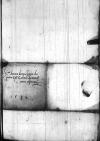Cum subito abiret is nuntius, non potui more meo longus esse. Mitto Vestrae Reverendissimae Dominationi ⌊⌋ ⌊Cornelii⌋ nostri, qui in aula ⌊regis Romanorum⌋ cum nostro ⌊Nipschicz⌋ convenit. Ex ⌊cuius⌋ ⌊⌋ uti existimo intelleget Vestra Reverendissima Dominatio, quam feliciter cessit ⌊Andreae de Aurea ⌋adversus ⌊Turcas⌋, quibus ademit ⌊Coronam⌋, ⌊Patras⌋, ⌊Castrum Novum⌋ et alia quaedam. Mercatores nostri affirmant et ⌊Modonam⌋ captam esse, Deus reliqua secundet.
Dominus ⌊Nipschicz⌋ sperat regem ⌊Ferdinandum⌋ missurum nuntios ad tractandum concordiam cum ⌊adversario⌋ suo in aula serenissimi ⌊regis⌋ nostri. Utinam felicius cedat, quam annis superioribus.
De domino ⌊Opalenski⌋, qui ad ⌊Turcam⌋ est superinscribed in place of crossed-out pe⌈peestest superinscribed in place of crossed-out pe⌉ missus, nihil dum scimus. ⌊Valachus⌋ iterum hostilia minatur nobis, serenissimi ⌊principes⌋ nostri ad conventum ⌊Petrkoviam⌋ proficiscentur, accepi illustrem dominum ⌊ducem Prussiae⌋ illuc quoque venturum, qui ita animum suum instituisse dicitur, ut aliquid agat contra statum ecclesiasticorum written over cum⌈cumorumorum written over cum⌉, quamvis apud me credibile non videtur. Risimus hic episcoporum ⌊ipsius⌋ vesanam mentem, qua sine lege, sine ratione sumunt sibi imperium et iurisdictionem in Dominatione Vestra Reverendissima eiusque ⌊dioecesi⌋ utque illorum displicuit audacia, ita summe placuit Vestrae Reveredissimae Dominationis responsum, quod et ⌊maiestas⌋ et probavit, et dixit non esse mutum et, verum domino ⌊duci⌋ non loquebatur, quod obturatas aures habeat ad veritatis vocem.
Valeat felix Vestra Reverendissima Dominatio.


 AAWO, AB, D. 67, f. 159v
AAWO, AB, D. 67, f. 159v